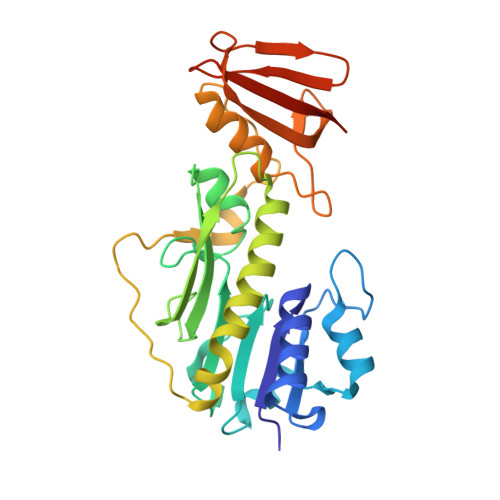Investigation of the enzymes required for the biosynthesis of an unusual formylated sugar in the emerging human pathogen Helicobacter canadensis.
Heisdorf, C.J., Griffiths, W.A., Thoden, J.B., Holden, H.M.(2021) Protein Sci 30: 2144-2160
- PubMed: 34379357
- DOI: https://doi.org/10.1002/pro.4169
- Primary Citation of Related Structures:
7N63, 7N67, 7N7A, 7N7B, 7N7C - PubMed Abstract:
It is now well established that the Gram-negative bacterium, Helicobacter pylori, causes gastritis in humans. In recent years, it has become apparent that the so-called non-pylori Helicobacters, normally infecting pigs, cats, and dogs, may also be involved in human pathology via zoonotic transmission. Indeed, more than 30 species of non-pylori Helicobacters have been identified thus far. One such organism is Helicobacter canadensis, an emerging pathogen whose genome sequence was published in 2009. Given our long-standing interest in the biosynthesis of N-formylated sugars found in the O-antigens of some Gram-negative bacteria, we were curious as to whether H. canadensis produces such unusual carbohydrates. Here, we demonstrate using both biochemical and structural techniques that the proteins encoded by the HCAN_0198, HCAN_0204, and HCAN_0200 genes in H. canadensis, correspond to a 3,4-ketoisomerase, a pyridoxal 5'-phosphate aminotransferase, and an N-formyltransferase, respectively. For this investigation, five high-resolution X-ray structures were determined and the kinetic parameters for the isomerase and the N-formyltransferase were measured. Based on these data, we suggest that the unusual sugar, 3-formamido-3,6-dideoxy-d-glucose, will most likely be found in the O-antigen of H. canadensis. Whether N-formylated sugars found in the O-antigen contribute to virulence is presently unclear, but it is intriguing that they have been observed in such pathogens as Francisella tularensis, Mycobacterium tuberculosis, and Brucella melitensis.
Organizational Affiliation:
Department of Biochemistry, University of Wisconsin, Madison, Wisconsin, USA.















